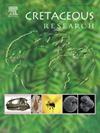New genus of falsiformicid wasps (Hymenoptera, Vespoidea: Falsiformicidae) with brachypterous male from middle Cretaceous Kachin amber in Myanmar
IF 1.7
3区 地球科学
Q1 GEOLOGY
引用次数: 0
Abstract
Falsiformicidae is a poorly known extinct family of aculeate wasps. It is known only as inclusions in various Cretaceous ambers. Brachypterous male Falsiformix pedestris Zhang and Rasnitsyn gen. et sp. nov. is described in the family Falsiformicidae based on a unique fossil from the middle Cretaceous Kachin amber. Occurrence and meaning of the male flightlessness in Hymenoptera is discussed. A combination of the flightless males with flying females occurs when mating takes place shortly after the eclosion, before adults disperse from confined space where they developed. An equally rare even if less exotic strategy with males and females both being flightless depends on the female pedestrian habits rather than on the pre-dispersal mating. Wide spatial (Angara Land, Laurussia Land and Gondwana Land) and narrow temporal distribution (Cenomanian and Turonian ages only) indicate Falsiformicidae as a possibly important stratigraphical indicator.
缅甸中白垩世克钦琥珀伪蜂新属(膜翅目,茧总科:伪蜂科)及短翅雄蜂
假蜂科是一个鲜为人知的已灭绝的有刺黄蜂家族。人们只知道它是各种白垩纪琥珀中的内含物。根据中白垩世克钦琥珀的独特化石,描述了短翼雄性证伪科(pseudoformicidae)的pseudoformix Zhang和Rasnitsyn gen. et sp. 11。讨论了膜翅目昆虫雄性无飞性的发生及其意义。不会飞的雄性和会飞的雌性交配发生在羽化后不久,在成虫从它们发育的密闭空间散开之前。一种同样罕见的策略——雄性和雌性都不会飞——取决于雌性的行走习惯,而不是分散前的交配。广泛的空间分布(Angara Land、Laurussia Land和Gondwana Land)和狭窄的时间分布(仅在Cenomanian和Turonian年龄)表明假虫科可能是重要的地层标志。
本文章由计算机程序翻译,如有差异,请以英文原文为准。
求助全文
约1分钟内获得全文
求助全文
来源期刊

Cretaceous Research
地学-地质学
CiteScore
4.10
自引率
19.00%
发文量
235
审稿时长
12 weeks
期刊介绍:
Cretaceous Research provides a forum for the rapid publication of research on all aspects of the Cretaceous Period, including its boundaries with the Jurassic and Palaeogene. Authoritative papers reporting detailed investigations of Cretaceous stratigraphy and palaeontology, studies of regional geology, and reviews of recently published books are complemented by short communications of significant new findings.
Papers submitted to Cretaceous Research should place the research in a broad context, with emphasis placed towards our better understanding of the Cretaceous, that are therefore of interest to the diverse, international readership of the journal. Full length papers that focus solely on a local theme or area will not be accepted for publication; authors of short communications are encouraged to discuss how their findings are of relevance to the Cretaceous on a broad scale.
Research Areas include:
• Regional geology
• Stratigraphy and palaeontology
• Palaeobiology
• Palaeobiogeography
• Palaeoceanography
• Palaeoclimatology
• Evolutionary Palaeoecology
• Geochronology
• Global events.
 求助内容:
求助内容: 应助结果提醒方式:
应助结果提醒方式:


